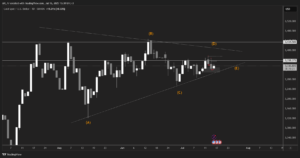Wall Street is expecting a week full of turbulence.
Wall Street investors anticipate a messy week with all the expected economic data that is said to be released and would cause a lot of market turbulence.
The elasticity of the US labor market is one of – if not the largest – sources of stress in markets. Federal Reserve officials have said on numerous occasions that they believe high inflation rates will remain steady until employment numbers and the pace of wage increases turn lower. The Fed’s painful rate hike will likely continue until the labor market boils over. However, the labor market is flexible and adapting to the higher living costs through wage increases, while unemployment rates are near their lowest historical levels.
In just one year, the Fed raised interest rates from near zero to 4.5% to 4.75% to contain inflation in the economy. Meanwhile, job numbers have surpassed expectations over the past ten months. The labor market is more vital than ever: The US added 517,000 jobs in January, pushing unemployment to its lowest level since 1969.
Even with mass layoffs at companies like Facebook, Google, Goldman Sachs, Intel, and Microsoft, job vacancies still outnumber job seekers by about 2 to 1. The Fed’s response has been to keep raising interest rates.
On Saturday, San Francisco Fed President Mary Daly stated that it is necessary to continue tightening the monetary policy for extended periods to put this cycle of high inflation behind.
She added that in the absence of a significant increase in the proportion of working-age adults looking to be employed or a substantial change in migration flows, unemployment rates would continue to decline, and labor shortages would continue, leading to higher wages and, eventually, higher prices.
Federal Reserve Chairman Jerome Powell will address the Senate Banking Committee on Tuesday and the House Financial Services Committee on Wednesday. Powell will deliver the semi-annual monetary policy report to Congress, where lawmakers will address him with their questions.
The dollar is falling while the market awaits the testimony of the US Federal Reserve Chairman in Congress.
The dollar fell broadly on Monday, March 6, as investors await US Federal Reserve Chairman Jerome Powell’s testimony before Congress, as well as the February jobs report, which will be released at the end of the week, and is likely to influence the Fed’s interest rate decision.
The dollar index, which measures the performance of the US currency against six major currencies, fell 0.182% to 104.420. Last week, the index incurred its first weekly loss since January.
After significant increases in US interest rates over the past year, the Fed raised rates by 25 basis points in its most recent two meetings. Still, solid economic data fueled fears in the market that the bank will return to raise interest strongly. The focus will be on the February jobs report due next Friday and Powell’s testimony to Congress on Tuesday and Wednesday.
Citi strategists expect Powell to indicate a preference for a 25 basis point rate hike but will leave all options open as he will speak before the jobs data is released.
Citi expects an increase of 255,000 jobs after the impressive expansion in January. They added that a significant increase would lead to a rise in interest rates by 50 basis points.
The euro rose 0.07% to $1.0641 after increasing 0.8% last week, and the pound reached $1.2029 in its latest trading, down 0.09% during the day.
The Japanese yen rose 0.10% to 135.74 yen per dollar ahead of the latest monetary policy meeting by Bank of Japan Governor Haruhiko Kuroda on Friday.
The Chinese yuan fell today after China announced a modest target for economic growth in 2023 of about 5%. In the spot market, the yuan opened trading in overseas markets at 6.9072 yuan per dollar and reached 6.9137 in the latest transaction. The Australian dollar fell 0.21% to $0.675, and the New Zealand dollar fell 0.16% in the latest trading to $0.621.
European stocks rise at the opening session of this trading week.
European stocks rose at the beginning of the week’s trading as investors await the testimony of Federal Reserve Chairman “Jerome Powell” before Congress, and the US jobs report, which will be released on Friday.
Powell will make remarks to Congress on Tuesday and Wednesday, which may give a better insight into the central bank’s view on inflation and interest rates.
The Stoxx Europe 600 Index rose by 0.22%, to 465 points, at exactly 08:09 GMT.
The British FTSE 100 index settled at 7,947 points, the German DAX rose 0.14% to 15,600 points, and the French CAC rose 0.45% at 7,381 points.
Investors are awaiting necessary data release today, including retail sales in the eurozone in January and factory orders in Germany.
Japan’s Nikkei index closed higher after hitting a 3-month high.
The Japanese Nikkei index rose more than 1% Monday, March 6, to its highest level in three months, tracing the impact of the gains made by Wall Street in the last session after officials of the US Federal Reserve calmed fears of excessive tightening of monetary policy.
Interest-sensitive technology stocks topped gainers in Japan, as was Wall Street, after Richmond’s Federal Reserve Bank President Thomas Parkin said inflation was likely past its peak, contributing to a decline in long-term Treasury yields from their highest level in several months.
Tokyo Electron stock provided the biggest support for the Nikkei, as it alone represented 50 points of the index’s gains of 310 points, up 3.1%. Sony shares closed up 2.56%.
Shares in startup investment firm SoftBank rose 2.74% after getting additional support from news that its ARM unit aims to raise at least $8 billion from a US listing.
The Nikkei index rose 1.11% to close at 28,237.78 points. The index started trading above the threshold of 28,000 points and advanced to 28,288.62 for the first time since December. Among the 225 stocks on the Nikkei index, 161 rose, 59 fell, and five remained unchanged. The Topix index increased by 0.84%, recording 2036.49 points.
Oil prices fell after expectations of modest growth in China.
Oil prices fell in early trading on Monday after China set a modest target for economic growth this year of around 5%, below market expectations of 5.5% growth for the world’s second-largest oil consumer. Brent crude futures were trading down 50 cents, or 0.6%, at $85.33 a barrel at 01:47 GMT. US crude futures fell 46 cents, or 0.6%, to $79.22 a barrel.
China’s growth forecast, which is being watched closely, fell short of last year’s target of 5.5% and came in at the lower end of expectations.
On Sunday, Chinese Premier Li Keqiang said it is necessary to consolidate the foundation of stable growth in China, and insufficient demand remains an obvious problem. At the same time, the expectations of investors and private companies are unstable.
At the same time, oil prices are likely to be impacted by global interest rate hikes as international central banks tighten policy due to fears of rising inflation. Traders are beginning to factor in interest rate increases worldwide but are hoping for smaller increases than last year.
Federal Reserve Chairman Jerome Powell will testify before Congress on Tuesday and Wednesday. He will likely be questioned whether a larger rate hike is needed in the world’s largest oil consumer.
Future increases in interest rates in the US will also likely depend on what the February jobs report reveals on Friday, followed by the February inflation report due next week.
European Central Bank President Christine Lagarde said over the weekend that it was highly probable they would raise interest rates this month to curb inflation. The Australian central bank is expected to increase interest rates by 25 basis points on Tuesday.
Disclaimer: This article is not investment advice or an investment recommendation and should not be considered as such. The information above is not an invitation to trade and it does not guarantee or predict future performance. The investor is solely responsible for the risk of their decisions. The analysis and commentary presented do not include any consideration of your personal investment objectives, financial circumstances, or needs.





